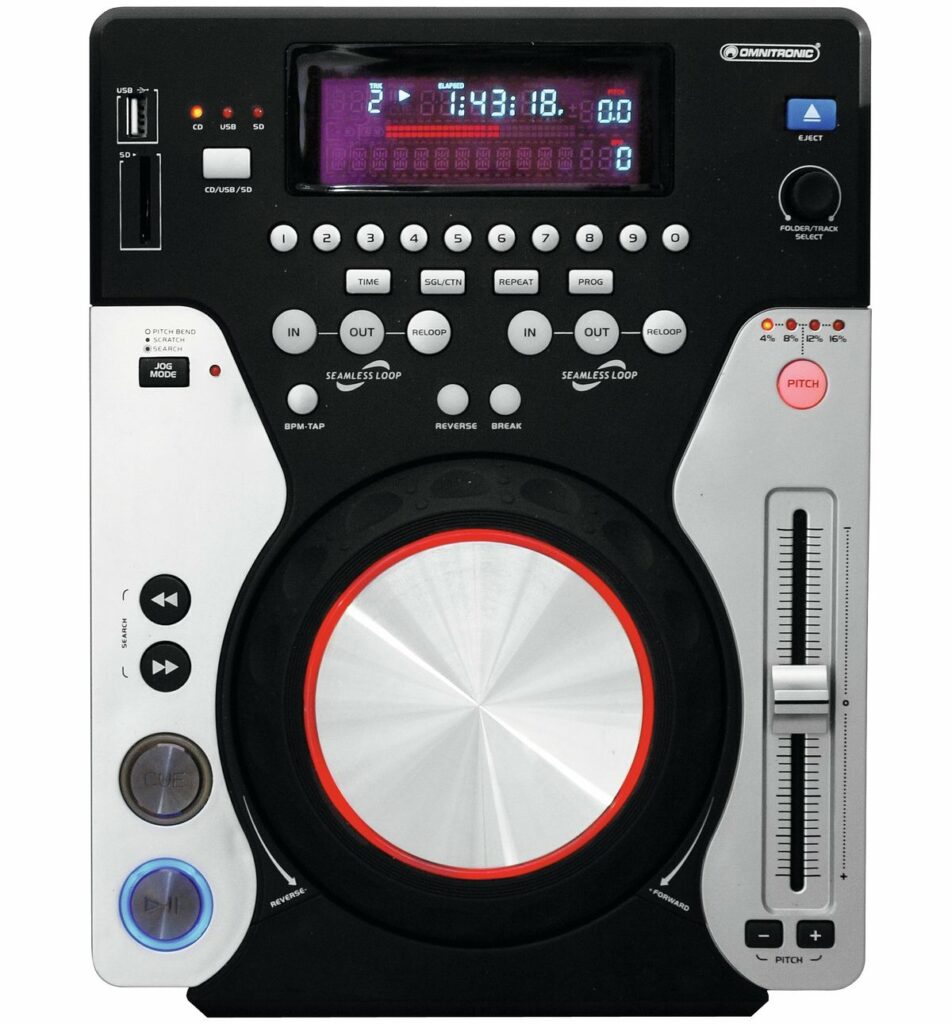Searching for CDJ-style media players on a tight budget? Look no further than Omnitronic’s affordable XMT. Greg Scarth checks out this entry-level offering.

For professional DJs, there are two main choices of media player: Pioneer’s CDJ series is widely considered an industry standard, while Denon’s SC series provides fierce competition. One big problem is that neither brand offers an affordable option for beginners or those on a tight budget. With the entry-level CDJ-350 discontinued, the cheapest Pioneer media player is now the XDJ-700, which comes in at over £600 per unit and can’t play CDs. Denon’s DJ players don’t really cater to the entry-level market at all, meaning that your best option would be a £1,500 SC6000 Prime player and an LC6000 layer controller to pair with it; a powerful combo but not exactly beginner-friendly at just over £2,000 in total. Clearly there’s a gap in the market for affordable media players. Enter Omnitronic’s XMT-1400 Mk2, coming in at just over £260 and offering an entry-level option for those who don’t want to head down the route of all-in-one controllers.
The XMT-1400 was originally released in 2011, but recently updated to Mk2 spec. Aside from some minor cosmetic changes and tweaks to the alphanumeric display, the Mk2 is a tiny bit heavier and slightly more efficient in terms of power consumption, but functionality is just about identical. Visually, the XMT is clearly heavily inspired by the old Pioneer CDJ-400, with a two-tone black and silver colour scheme plus a similar control layout. It can play from USB, SD card or CD (audio or MP3). Features are very basic, with an auto loop option, a handful of vinyl-style functions and a manual BPM counter. There’s no sync option to beat match automatically – in fact, there are no digital connections whatsoever, meaning you can’t connect two players and you’ll need separate SD cards/USB sticks for each if you’re using more than one.

Before going any further, it’s worth questioning why you’d want an entry-level media player like this. The elephant in the room is that Pioneer and Denon don’t offer anything in this price range because the beginner DJ market is now dominated by all-in-one controllers such as the Pioneer DDJ-400. Hooking up to a laptop running suitable software, controllers like the DDJ are a convenient way to learn the ropes of mixing.
So why might you want something like the XMT-1400 instead? Perhaps you don’t have a laptop, ruling out the option of using a controller without significant further investment. Perhaps you’re mainly a vinyl DJ and you just want a cheap and cheerful option for playing the occasional digital file as part of a mix. Perhaps you don’t like the idea of all your setup being part of a single unit; if part of an all-in-one controller breaks, the whole thing’s often rendered useless. Separate players and mixer, on the other hand, allow you to swap out individual parts for simple replacement or upgrades as you advance to more professional gear. Entry-level media players might not be the mainstream choice, but there are still plenty of reasons why people might want them.

In use, the XMT-1400 is bare bones as you’d expect, but it’s all functional and logical in its layout, which isn’t a million miles off the standard setup you’d expect from Pioneer or Denon. Choosing and loading tracks isn’t exactly as quick and easy as you’d find it on a modern touchscreen CDJ, but it gets the job done. With a track loaded, you can then search through it with the jog wheel and set a cue point which is stored until you load another track. There are no track analysis, hot cues or performance pad options like you’d find on high-end players. Instead, BPM analysis is effectively manual, defined by tapping the BPM-tap button until the tempo is displayed. From here, you can adjust the pitch using the fader (with a choice of 4%, 8%, 12% or 16% range) and bend the pitch temporarily to mix tracks using the jog wheel or pitch bend buttons.

There aren’t many fancy features to write home about, but what’s there works nicely. Two loops can be created quickly by tapping the In and Out buttons in the Seamless Loop sections, deactivating when you tap the Out button again and then recalled when you hit one of the Reloop buttons. Meanwhile, vinyl-style effects can be created when you select Scratch using the Jog Mode button, allowing you to scratch with the jog wheel. The Brake option gives you a vinyl-style lag to startup and stop, while the Reverse button instantly switches playback into reverse. Simple but effective.

At just over £260 each, the XMT-1400 Mk2s offer a decent range of bare-bones features for those who want the convenience and functionality of standalone media players without dropping £1,200+ on Pioneer XDJs or £2,000+ on a Denon setup. The closest rival – in fact, the only real alternative – is the Numark NDX-500 at around £230 each; the Numarks have features like hot cues and Serato support, but the Omnitronics have better looping options and feel like a less cluttered, more straightforward design. The XMT-1400 isn’t meant to be a serious pro option, but for its price point it’s a solid, well-built choice with good sound quality and all the basic features taken care of.
Greg Scarth
More info/buy